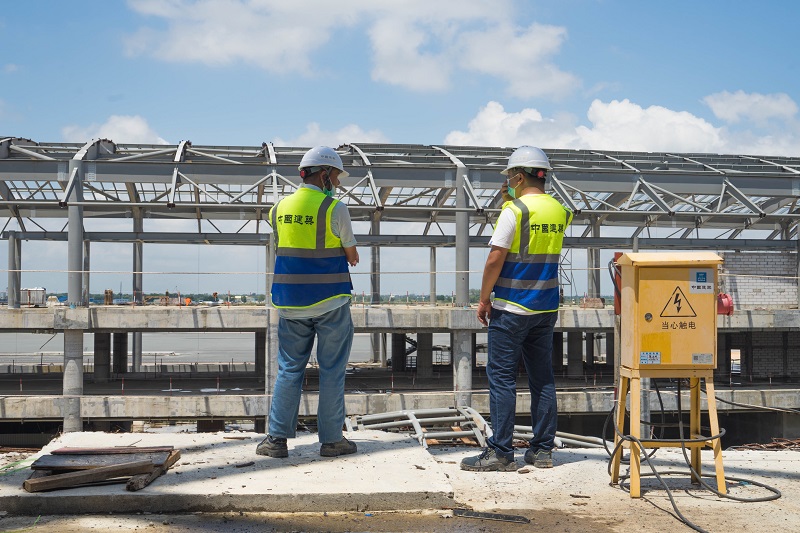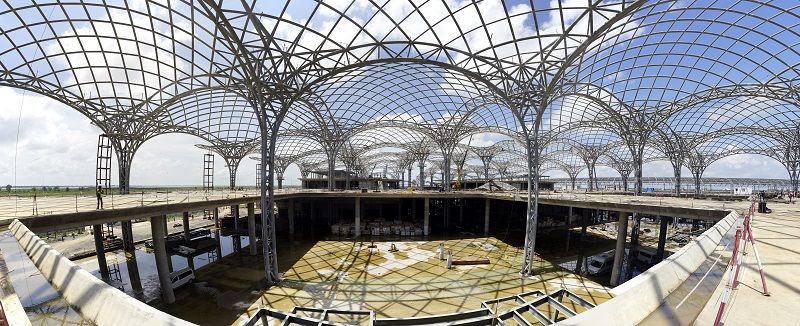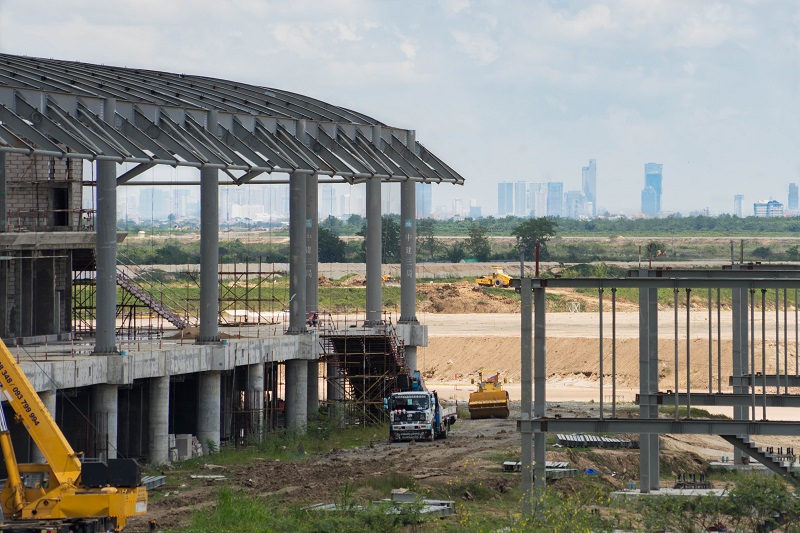Phnom Penh New Airport Terminal 40 Percent Complete

- By François Camps
- October 10, 2022 6:30 PM
PHNOM PENH – The control tower can now be seen from afar. Measuring 118 meters high, it rises above a vast plot of sand that used to be rice fields and symbolizes the construction of the new Phnom Penh International Airport, which is due to start operations in January 2025.
“The construction of the terminal building is 40 percent complete and should be over by the end of 2024,” said Yee Con Long, director of Cambodia Airport Investment Company (CAIC) during a site visit on Oct. 4.
CAIC, whose role is to develop the airport, is a joint venture established in 2018 by the local conglomerate Overseas Cambodian Investment Corporation (OCIC) and the government, through the State Secretariat of Civil Aviation. Holding 90 percent of the shares, OCIC, which is known for being the developer of artificial islands Koh Pich and Koh Norea, is the main shareholder.
 A worker stands next to a sign at the new Phnom Penh International Airport. Photo: Francois Camps
A worker stands next to a sign at the new Phnom Penh International Airport. Photo: Francois Camps
Located around 20 kilometers south of downtown Phnom Penh, the airport – also called Techo International Airport – will be one of the biggest in the region.
Spanning over 2,600 hectares, it will be built in three phases. Each will comprise its own apron and a 4-kilometer runway capable of handling large long-haul aircraft such as the Airbus A380-800 and Boeing 747-800.
Phase one is under construction and is set to be over by the end of 2024, for an opening in January 2025, said Con Long. While the first phase targets 13 million passengers a year, the completion of phase two is believed to bring the tally to 30 million passengers in 2030.
“Then, when we will have reached substantial results, we will launch the building of phase three, but no precise timeline has been set,” added Con Long.
 Two workers look on at the construction site of the new Phnom Penh International Airport. Photo: Francois Camps.
Two workers look on at the construction site of the new Phnom Penh International Airport. Photo: Francois Camps.
“With phase three, the airport will have another terminal, south of the first one, and a third runway. Altogether, it will accommodate up to 50 million passengers a year.”
A highway crossing through rice fields is also being built to connect with the southernmost part of Hun Sen boulevard. “The soil settlement is nearly done and will lay for one year. After that, we will cast the concrete pavement and make sure the road is ready in 2024,” he said.
“With the new airport, Cambodia aims to become a regional hub,” argues Thierry Tea, development manager at OCIC.
“The location of the current airport doesn’t allow any major infrastructure development so it had to be done somewhere else, where space is plenty.”
Cambodia Airport operates Cambodia’s three international airports – Phnom Penh Pochentong, Siem Reap, and Sihanoukville. It said Cambodia received 11.7 million passengers in 2019, before the start of the COVID-19 pandemic.
 A panorama view of the under-construction new Phnom Penh International Airport. Photo: Francois Camps
A panorama view of the under-construction new Phnom Penh International Airport. Photo: Francois Camps
That year, the current Phnom Penh international airport received six million passengers, far below the target the new airport has set for its phase one.
Funding is also a critical point. The vast majority of the $1.5 billion required to finance the entire project was supposed to come from the state-run China Development Bank. But the cooperation agreement signed in 2018 was revoked last year, leaving a $1.1 billion hole in the financing plan.
As a result, CAIC started to issue bonds in November 2021 to wrap up its budget. Mostly subscribed by local insurance companies and banks, they allowed CAIC to raise $300 million, to which is added OCIC’s direct investment.
 A view of the construction site of the new Phnom Penh International Airport. Photo: Francois Camps
A view of the construction site of the new Phnom Penh International Airport. Photo: Francois Camps
“There is not a single dollar of Chinese money financing the airport. The current $500 million budget comes entirely from Cambodia and is about 40 percent of the project completion,” confirmed Tea. “OCIC is committed to financing the next phases,” he added.
While the design of the airport has been carried out by Foster & Partners, a UK company, construction is being handled by state-owned Chinese corporations. China Construction Third Engineering Bureau, a subsidiary of China State Construction Engineering, is building the terminal.
The runway, taxiway, apron and related facilities are made by Shanghai Baoye Group, a subsidiary of Metallurgical Corporation of China (MCC).
 The construction site of the new Phnom Penh International Airport. Photo: Francois Camps
The construction site of the new Phnom Penh International Airport. Photo: Francois Camps
The completion of the new Phnom Penh international airport was erroneously given as 60 percent, instead of 40 percent, in the original version of the story.















